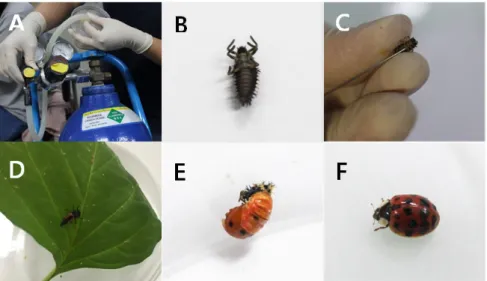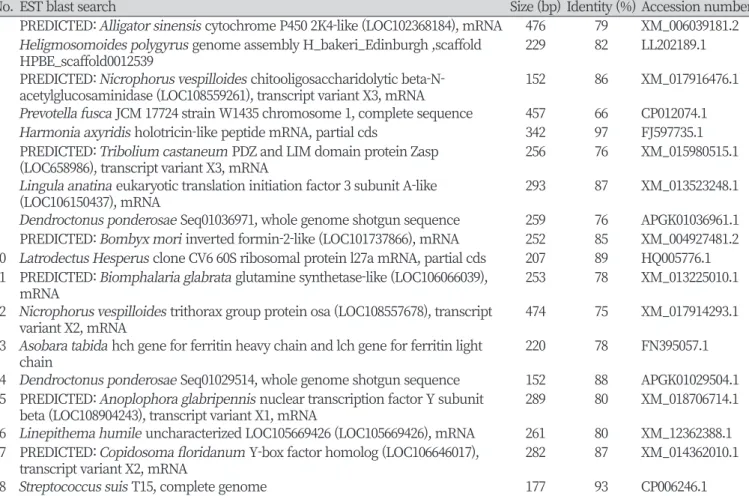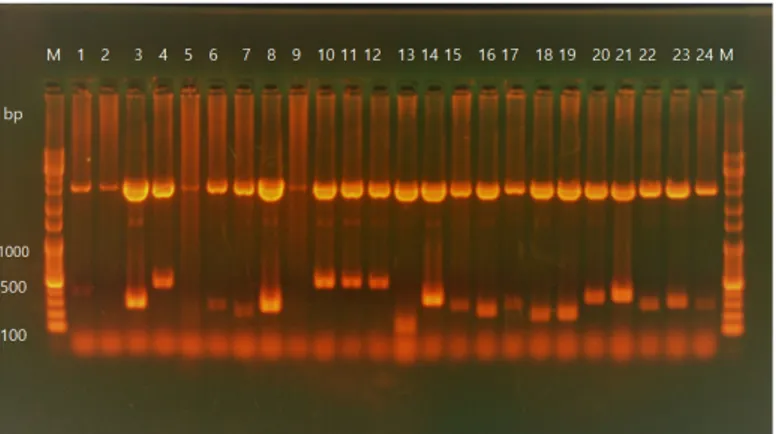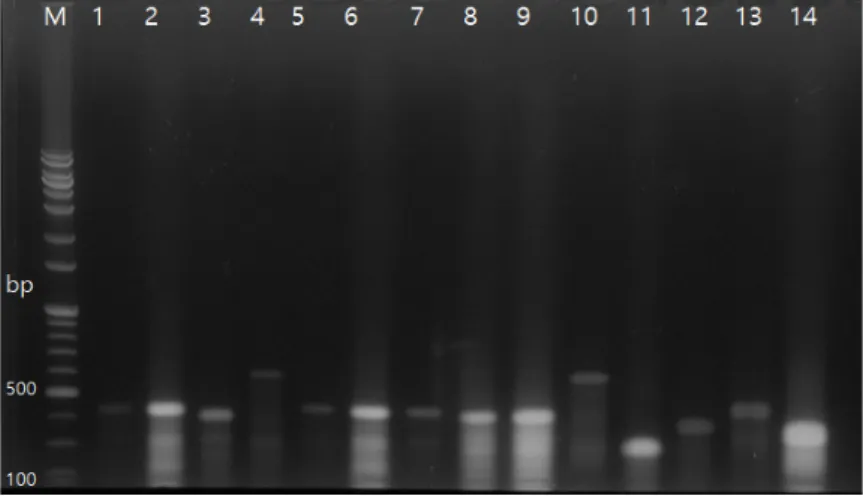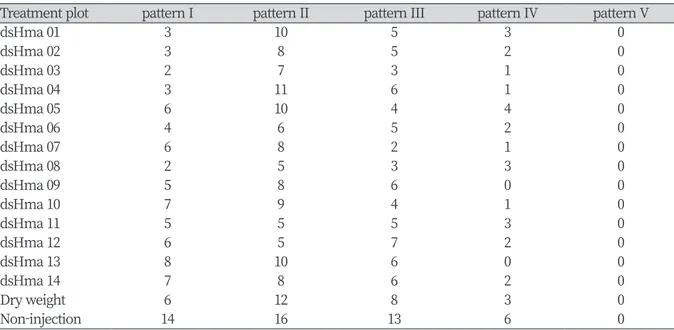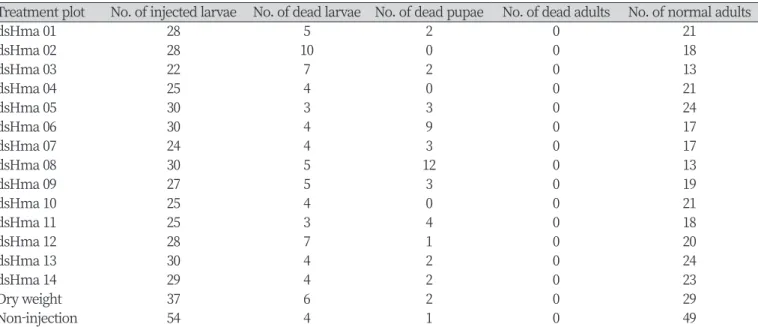This is an Open Access article distributed under the terms of the Creative Commons Attribution Non-Commercial License (http: //creativecommons.org/licenses/by- nc/4.0/) which permits unrestricted non-commercial use, distribution, and reproduction in any medium, provided the original work is properly cited.
Copyright: © 2019 Korean Journal of Agricultural Science
https://doi.org/10.7744/kjoas.20190031
PLANT & FOREST
Gene functional analysis of Harmonia axyridis by in vitro transcription
Sang-Eun Park, Young-Nam Youn
*Department of Agricultural Biology, College of Agriculture and Life Sciences, Chungnam National University, Daejeon 34134, Korea
*
Corresponding author: youngnam@cnu.ac.kr
Abstract
Random genes were screened in two transforming ways to investigate the new genes of a ladybug using the Harmonia axyridis cDNA library stock cell cloned in the LITMUS 28i vector in a previous study. Phenotypic variation was observed after injection of the synthesized double-stranded RNA through the in vitro transcription process. The cDNA library of H.
axyridis was transformed into E. coli DH5α and 10B competent cells by heat shock. Analysis of the nucleotide sequences of the 42 clones with the insert DNAs revealed that 21 clones were homologous with the genes of insects, and only one clone had a gene from H. axyridis.
Thirteen of the 21 insect genes were homologous with genes from coleopteran insects.
Fourteen genes were selected, which were identified by the gene screening results, and were synthesized as double-stranded RNA through in vitro transcription. One microgram of the synthesized double-stranded RNA between segments T1 and T2 were injected using a syringe into each anesthetized fourth larvae which were under 2 days old. As a result, a phenotypic variation appeared in the larva injected with the two genes. While the eggs of H. axyridis injected with distilled water hatched out three days after oviposition, the eggs of H. axyridis injected with dsHma 06 did not hatch but become shrivel a week after oviposition. Most of the H. axyridis injected with dsHma 08 died and were unable to complete the pupation or eclosion during ecdysis.
Keywords: gene functional analysis, Harmonia axyridis, in vitro transcription
Introduction
무당벌레(Harmonia axyridis)는 딱정벌레목(Coleoptera) 무당벌레과(Coccinellidae)에 속하는 곤 충으로 중앙아시아, 동아시아의 토착종이며(Dobzhansky, 1933; Majerus, 1994; Coderre et al., 1995;
Koch, 2003), 여러 종류의 진딧물, 깍지벌레, 응애, 총채벌레 등과 같이 연조직으로 되어있는 해 충을 포식하는 주요한 천적으로 알려져 있다(Choi and Kim, 1985; Gordon, 1985; Ferran et al., 1986;
Ferran et al., 1996; Hodek and Honek, 1996; Seo and Youn, 2000, 2001; Koch, 2003). 무당벌레는 전세계 적으로 약 490속, 4,000여종이 보고되어 있으며(Singh, 1977), 우리나라에서는 38속 74종이 보고되 어 있고(ESK and KSAE, 1994), 북아메리카에서 400여 종(Belicek, 1976), 유럽에는 110여종이 분포 OPEN ACCESS
Accepted: June 17, 2019 Revised: May 31, 2019 Received: April 11, 2019 DOI:
Citation: Park SE, Youn YN. 2019.
Gene functional analysis of Harmonia axyridis by in vitro transcription. Korean Journal of Agricultural Science. https://
doi.org/10.7744/kjoas.20190031
하고 있을 뿐만 아니라 남아메리카, 아프리카 등지에 이르기까지 전 세계적으로 분포하고 있다(Iperti, 1986; Chapin and Brou, 1991; Day et al., 1994; Tedders and Schaefer, 1994; Coderre et al., 1995; Kidd et al., 1995; Lamana and Miller, 1998; Koch et al., 2006; Brown et al., 2007). 또한 무당벌레는 성충과 유충이 모두 작물과 정원 식물에서 흡즙을 하여 가해를 하는 진딧물에 대한 포식력이 뛰어나 생물적 방제인자로서 많이 사용하고 있는 종으로 경제적으로 높은 가치를 가지고 있다(Markkula and Tittanen, 1980; Kauffman and Schwalbe, 1991; Freier and Triltsch, 1995; Seo and Youn, 2000, 2001, 2002; Koch, 2003). 그러나 미국에서 천적으로써 순기능 말고도 농작물을 가해하거나 다른 무당벌레 종의 개체군을 감소시키는 침투외래종으로 보고되기도 하였다(Koch et al., 2004; Roy and Wajnberg, 2008; Kenis et al., 2007; Koch and Galvan, 2008). 한편, 무당벌레의 또 다른 특징은 초시에 나타나는 다양한 색상과 무늬로 이에 관하여 많은 사람들이 연구를 해오고 있다. 곤충의 날개에 나 타나는 다양한 패턴형성의 메커니즘은 세포생물학적, 유전학적, 생화학적인 측면에서 뿐만 아니라 발생학적인 측면 에서도 아주 흥미로운 문제로 다뤄지고 있었으며(Oshima et al., 1956), 무당벌레의 초시무늬의 색상패턴은 과거에 서로 다른 종 혹은 다른 속의 곤충으로 분류되었을 정도로 다형성을 가진다고 보고되었다(Tan, 1946). 또한 Soares et al. (2001) 는 100여종 이상의 다른 초시무늬 패턴을 보고하였으며, Tan and Li (1932) 또한 지역별로 다른 200여종 이상의 초시무늬 패턴을 보고한 바 있다. 국내에서는 초시색상 패턴의 유전 및 관련 유전자 탐색을 위하여 곤충의 색소침적에 관여하는 prophenlooxidease (PPO) 유전자가 무당벌레 내에 존재하는지 연구한 바가 있으며, amplified fragment length polymorphism (AFLP) 를 통해 초시색상패턴의 변이를 분석하여 초시색상과 관련이 있는 AFLP 분자지표 10개 중 5개를 sequence characterized amplified region (SCAR) 분자지표로 성공적으로 전환한 연구가 보고되었다(Kim et al., 2012; Park et al., 2016).
또한 Seo et al. (2007)이 무당벌레 초시무늬의 표현형 변이와 유전적인 상관에 관한 연구에서 유전적인 요인 뿐만 아니 라 환경적인 요인이 복합적으로 작용하여 초시무늬를 결정한다고 보고한 바 있으며, 유충시기의 먹이 양, 번데기 기 간 동안의 온도와 습도, 계절의 변화 등이 초시무늬 발현 비율에 영향을 미칠 수 있다고 보고되었다(Komai, 1956; Osawa and Nishida, 1992; Grill and Moore, 1998). 이 뿐만 아니라 평균기온과 일조량이 높고 길수록 멜라닌계통의 색상패턴 발현 율이 높게 나타난다고 보고된 바 있다(Kang et al., 2009). 그러나 무당벌레 초시무늬 패턴형성에 어떠한 요인에 의해 변 이가 일어나는 정확하게 밝혀진 연구가 없다.
RNAi (RNA interference) 는 dsRNA (double-stranded RNA)에 의해 배열 특이적으로 mRNA가 분해되는 유전자 발현 억제 현상으로, 세포 내로 dsRNA가 이입되면 RNase III군에 속하는 Dicer에 의해 21 - 25 nt의 siRNA (small interfering RNA)로 절 단되고, 이렇게 생긴 siRNA가 RISC (RNA induced silencing complex)와 결합한 후에 상보적인 배열을 갖는 mRNA에 결합 하여 선택적으로 분해함으로써 mRNA의 발현을 억제시키는 과정을 거친다(Fire et al., 1998; Sijen et al., 2001; Bellés, 2010).
이러한 RNAi 기법은 예쁜꼬마선충(Caenorhabditis elegans)에서 처음으로 확인한 이후로(Fire et al., 1998), 유전자 기능 분 석을 위해 폭넓게 이용하고 있으며(Fjose et al., 2001), 딱정벌레목(거짓쌀도둑 거저리, 무당벌레, 좀남색잎벌레, 운남점 얼룩하늘소), 바퀴벌레목(독일바퀴, 이질바퀴), 파리목(노랑초파리, 이집트숲모기, 쉬파리, 구리금파리, 호리꽃등에), 노 린재목(담배가루이, 침노린재, 긴노린재), 벌목(양봉꿀벌, 파리금좀벌), 나비목(담배거세미나방, 파방나방, 박각시나방,
화랑곡나방), 메뚜기목(풀무치, 쌍별귀뚜라미), 흰개미목, 풀잠자리목 등 많은 곤충에서 연구되었고(Bellés, 2010; Kim et al., 2015; Ko and Youn, 2015), 농업 환경에서 해충을 방제하기 위해 잠재적으로 사용될 수 있는 새로운 대안으로 제안되 고 있다(Baum et al., 2007; Mao et al., 2007; Huvenne and Smagghe, 2010). 곤충에서 유전자 기능 분석에 대한 RNAi의 첫 성공 적인 적용은 초파리 배아에 dsRNA를 주입한 연구이며(Kennerdell and Carthew, 1998), 그 이후에 다핵배반으로 dsRNA를 주입하는 embryonic RNAi가 보고되었다(Fjose et al., 2001). 그러나 embryonic RNAi는 성충발달을 분석하기에 적합하지 않아 Tomoyasu and Denell (2004)은 곤충 체강으로 dsRNA를 주입하여 성충발달 분석에 용이한 larval RNAi를 보고하였다.
dsRNA 를 곤충 체내로 전달하는 방법은 먹이에 dsRNA를 처리하여 구강을 통해 전달하는 섭식 방법(feeding), 체내로 주
사기로 주입 하는 방법(injection), dsRNA solution에 흠뻑 적셔 흡수시키는 방법(soaking)이 있는데(Yu et al., 2013), 이러한
전달방법은 실제 포장에서 이용하기에 시간과 비용면에서 경제적이지 않아 더욱 효과적인 dsRNA 전달 방법이 필요하 다.
본 연구는 무당벌레의 초시무늬에 어떠한 유전자가 관여하는지, 또 아직 밝혀지지 않은 무당벌레의 유전자를 찾아 내기 위해서 선행 연구로 완성한 무당벌레의 cDNA library를 gene screening 하였으며, in vitro transcription으로 유전자를 선 발하고, 선발된 유전자를 RNA interference 기법으로 무당벌레에 적용하여 표현형 변이를 관찰하였다.
Materials and Methods
공시충 채집 및 사육
무당벌레(Harmonia axyridis)는 2015년 충청남도 금산군에서 채집한 월동개체군과 2016년 대전광역시 유성구 궁동에 서 채집한 야외개체군을 plastic insect breeding dish (직경 10 × 4 cm)에 목화진딧물, 복숭아혹진딧물을 진딧물의 기주 식 물과 함께 제공하여 누대사육하였다. 새로 태어난 세대의 4령 유충을 실험에 사용하였고, 모든 사육은 25 ± 1℃, 16L : 8D, 상대습도 50 - 60%의 조건에서 개체 사육하였다.
무당벌레 cDNA library 유전자 크리닝
E. coli DH5α competent cell을 이용한 유전자 스크리닝
· E. coli 형질전환
LITMUS 28i vector 에 클로닝한 무당벌레 cDNA library를 DH5α E. coli competent cell에 형질전환 켰다. 살짝 녹여진 DH5 α competent cell에 LITMUS 28i vector에 클로닝한 DNA plasmid를 1 μL 넣고, 가볍게 두드려 잘 섞이게 한다. 얼음에 5분동 안 넣어놓은 후에 45초 간 42℃에서 열 충격을 가했다. 열 충격 후, 2분간 얼음에 넣은 다음 LB broth 1 μL를 넣고 37℃ 진 탕배양기에서 1시간 동안 배양하였다. 1시간 후 ampicillin을 넣은 LB Plate에 300 μL를 도말 하고 37℃에서 하룻밤 동안 배양하였다.
· 콜로니 및 Plasmid DNA 분리
37 ℃에 하룻밤 동안 배양시켰던 ampicillin 배지를 꺼내어 단일 콜로니를 pipette tip을 이용하여 LB broth 3 μL에 분리하 였다. 37℃ 진탕배양기에서 180 rpm으로 하룻밤 동안 DH5α E.coli cell을 배양하였다. LB broth에 하루 동안 배양시킨 cell 을 Alkaline Lysis법을 이용하여 DNA를 추출하였다(Birnboim and Doly, 1979).
· 제한효소 처리 – EcoRI, HindIII
In vitro transcription 을 하기 위해 LITMUS 28i Vector (NEB, Korea)에 무당벌레 cDNA library를 클로닝한 것을 EcoRI과 HindIII 로 처리하여 삽입유전자의 크기를 확인하였다. Plasmid DNA 분리로 얻은 plasmid DNA 7 μL, EcoRI (NEB, Korea) 0.5 μL, HindIII (NEB, Korea) 0.5 μL, 2.1 buffer 1 μL, 증류수 1 μL (총 10 μL)를 37℃에서 6시간동안 반응시켰다.
E. coli DH10B competent cell을 이용한 유전자 스크리닝
· E. coli 전기충격 형질전환
LITMUS 28i vector 에 클로닝한 cDNA library는 Electroporator (Bio-Rad, USA)를 이용하여 ElectroMAX
TMDH10B Cells
(Invitrogen, USA)에 형질전환 시켰다. Electroporator는 voltage 1.8 kV, resistance 200 Ω, capacity 25 uF로 설정하였다. LITMUS
28i Vector (NEB, Korea) 에 클로닝한 cDNA library 2 μL를 넣어 총 100 μL를 냉각된 E. coli pulser
®cuvette (BIO-RAD, USA)
에 전기충격을 주고 나서 SOC medium 900 μL를 넣어 피펫팅 하였다. 피펫팅을 하고 나서 새로운 1.5 μL Eppendorf tube (Eppendorf, Germany)에 옮겨 1시간 동안 37℃ 진탕배양기에서 배양하였다. 1시간 후에 ampicillin이 들어간 LB plate에 10
-1부터 10
-4까지 희석하여 100 μL씩 도말하고 37℃에 하룻밤 동안 배양 후, 콜로니의 수를 세어 적정농도를 계산하고 무 당벌레 유전자 스크리닝하는데 사용하였다. 전기천공법 후에 사용하고 남은 cDNA library는 300 μL씩 aliquot하여 70%
glycerol 200 μL를 넣은 뒤 부드럽게 인버트 5번하여 - 80℃에 library stock으로 보관하였다.
· 콜로니 및 Plasmid DNA 분리
37 ℃에 하룻밤 동안 배양시켰던 ampicillin 배지를 꺼내어 단일 콜로니를 pipette tip을 이용하여 LB broth 3 μL에 분리 하였다. 37℃ 진탕배양기에서 180 rpm으로 하룻밤 동안 DH10B E.coli cell을 배양하였다. LB broth에 하루 동안 배양시킨 cell 을 Alkaline Lysis법을 이용하여 DNA를 추출하였다(Birnboim and Doly, 1979).
· 제한효소 처리 – EcoRI, HindIII
In vitro transcription 을 하기 위해 LITMUS 28i Vector(NEB, Korea)에 무당벌레 cDNA library를 콜로닝한 것을 EcoRI과 HindIII로 처리하여 삽입유전자 크기를 확인하였다. Plasmid DNA 분리로 얻은 plasmid DNA 7 μL, EcoRI (NEB, Korea) 0.5 μL , HindIII (NEB, Korea) 0.5 μL, 2.1 buffer 1 μL, 증류수 1 μL (총 10 μL)를 37℃에서 6시간동안 반응시켰다.
Double-stranded RNA 합성
Enzyme cutting – HpaI
무당벌레 cDNA library에서 삽입유전자가 확인된 임의의 유전자들을 double-stranded RNA로 합성하기 위해 LITMUS 28i vector에 클로닝되어 있는 plasmid 주형을 제한효소 HpaI으로 처리하여 선형( )으로 만들었다. 선형의 plasmid DNA 7 μL, Hpa I (NEB, Korea) 1 μL, Cutsmart Buffer 1 μL, 증류수 1 μL (총 10 μL)를 37℃에서 하룻밤 동안 반응시켰다.
Double-stranded RNA 합성
선형으로 만든 DNA 주형과 T7 RiboMax
TMExpress RNAi system kit (Promega, USA) 를 이용하여 14개의 double-stranded RNA를 합성하였다. RiboMax
TMExpress T7 2X Buffer 10 μL, 선형 DNA template 2 μL, Nuclease-Free Water 6 μL, Enzyme Mix, T7 Express 2 μL (총 20 μL)를 37℃에서 2시간동안 반응 시키고 dsRNA를 annealing 하기 위해 70℃에서 10분동안 반응시 킨 뒤 상온에서 20분동안 반응시켰다. dsRNA 이외에 남아있는 DNA template와 ssRNA를 제거 하기 위해서 200배 희석 시킨 RNase 1 μL, DNase 1 μL를 넣고 37℃에서 30분동안 반응시켰다. 반응시킨 dsRNA는 에탄올 다운을 하여 증류수 30
μL에 용리시켰다.
Double-stranded RNA 주입
탈피한 후 0 - 2일이 된 무당벌레 4령 유충에 in vitro transcription 과정을 통하여 합성한 dsRNA를 주입하였다. 유충 체내
로 직접 전달되게 하도록 dsRNA를 주입하기 3시간 전부터 굶겼으며, 표현형 변화를 효과적으로 비교하기 위해 대조구
로서 무처리구, 증류수 주입을 하였다. dsRNA는 syringe (Hamilton, USA)를 이용하여 한 처리구 당 25마리 내외의 무당벌
레 4령 유충에 1 μg/μL를 복부 제 1마디와 제 2마디 사이에 Niimi et al. (2005)의 방법을 참고하여 주입하였다. 주입한 후
에 성충이 될 때까지 목화진딧물과 복숭아혹진딧물을 먹이로 제공하였다(Fig. 1).
Results
cDNA library 유전자 스크리닝
E.coli DH5α competent cell을 이용한 유전자 스크리닝
· 삽입유전자 크기 확인
열 충격을 통해 얻어진 cDNA library에서 유전자를 선발하고 크기를 확인하기 위해서 10
-1로 희석하여 도말한 ampicillin 배지에서 무작위로 취하여 콜로니 prep을 하였다. Ampicillin 배지에 뜬 콜로니는 총 95개로, 그 중 72개를 콜로
Fig. 1. Process of injecting dsRNA into H. axyridis abdominal region. A, A ladybug was anesthetized by carbon dioxide gas; B, Anesthetized insect; C, Injection of dsRNA; D, After waking from the anesthetic; E: Pupa; F:
Observation of phenotype.
Fig. 2. Insert DNA of cDNA library was constructed from Harmonia axyridis on the electrophoresis. Plasmid
from 18 randomly selected colonies were analyzed on agarose gel for insert size. Insert size was confirmed
with the size of 150 - 500 bp. M, 1 kb plus ladder marker; Lane 1 - 18, Harmonia axyridis cDNA library random
gene insert.
니 prep하였으며, 중복되는 유전자를 제외하고 18개의 삽입유전자가 확인되었고, 그 유전자의 크기는 150 - 500 bp로 다 양한 크기를 확인할 수 있었다(Fig. 2).
· 염기서열분석 및 NCBI blast
LITMUS 28i vector에 클로닝 되어있던 무당벌레 cDNA library를 스크리닝한 24개의 유전자의 염기서열을 알아보기 위해 plasmid DNA를 분리하였고, 제한효소 EcoRI과 HindIII 처리를 통하여 삽입유전자를 확인한 후, 염기서열분석을 의 뢰하고(Macrogen, Korea), NCBI blast를 통해 중복되는 유전자가 있는지 확인하였다(Table 1). 그 결과 11개의 유전자는 곤 충 유전자와 상동성을 보이는 유전자로 확인되었고, 7개는 곤충이 아닌 다른 종의 유전자와 상동성을 보였으며, 무당 벌레 유전자는 1개가 확인되었다(Table 4). 무당벌레 유전자가 아닌 곤충 유전자 10개 중 6개가 딱정벌레목으로 무당벌 레와 유사한 종의 유전자가 확인되었다.
Table 1. NCBI blast search data of Harmonia axyridis cDNA library gene screening using E. coli DH5α competent cell for confirm redundancy.
No. EST blast search Size (bp) Identity (%) Accession number
1 PREDICTED: Alligator sinensis cytochrome P450 2K4-like (LOC102368184), mRNA 476 79 XM_006039181.2 2 Heligmosomoides polygyrus genome assembly H_bakeri_Edinburgh ,scaffold
HPBE_scaffold0012539 229 82 LL202189.1
3 PREDICTED: Nicrophorus vespilloides chitooligosaccharidolytic beta-N-
acetylglucosaminidase (LOC108559261), transcript variant X3, mRNA 152 86 XM_017916476.1 4 Prevotella fusca JCM 17724 strain W1435 chromosome 1, complete sequence 457 66 CP012074.1 5 Harmonia axyridis holotricin-like peptide mRNA, partial cds 342 97 FJ597735.1 6 PREDICTED: Tribolium castaneum PDZ and LIM domain protein Zasp
(LOC658986), transcript variant X3, mRNA 256 76 XM_015980515.1
7 Lingula anatina eukaryotic translation initiation factor 3 subunit A-like
(LOC106150437), mRNA 293 87 XM_013523248.1
8 Dendroctonus ponderosae Seq01036971, whole genome shotgun sequence 259 76 APGK01036961.1 9 PREDICTED: Bombyx mori inverted formin-2-like (LOC101737866), mRNA 252 85 XM_004927481.2 10 Latrodectus Hesperus clone CV6 60S ribosomal protein l27a mRNA, partial cds 207 89 HQ005776.1 11 PREDICTED: Biomphalaria glabrata glutamine synthetase-like (LOC106066039),
mRNA 253 78 XM_013225010.1
12 Nicrophorus vespilloides trithorax group protein osa (LOC108557678), transcript
variant X2, mRNA 474 75 XM_017914293.1
13 Asobara tabida hch gene for ferritin heavy chain and lch gene for ferritin light
chain 220 78 FN395057.1
14 Dendroctonus ponderosae Seq01029514, whole genome shotgun sequence 152 88 APGK01029504.1 15 PREDICTED: Anoplophora glabripennis nuclear transcription factor Y subunit
beta (LOC108904243), transcript variant X1, mRNA 289 80 XM_018706714.1
16 Linepithema humile uncharacterized LOC105669426 (LOC105669426), mRNA 261 80 XM_12362388.1 17 PREDICTED: Copidosoma floridanum Y-box factor homolog (LOC106646017),
transcript variant X2, mRNA 282 87 XM_014362010.1
18 Streptococcus suis T15, complete genome 177 93 CP006246.1
Table 2. Harmonia axyridis cDNA library titration after transforming in E. coli DH10B competent cell. The cDNA library titration was determined by counting colonies.
Dilution Amount plated (μL) Number of colonies/plate Titration (cfu/μL) Average titration (cfu/μL)
10
-2100 373 3.73 × 10
410
-3100 64 6.4 × 10
45.71 × 10
410
-4100 7 7 × 10
4E.coli DH10B competent cell을 이용한 유전자 스크리닝
· cDNA library 적정농도
Electroporator 를 이용하여 ElectroMAX
TMDH10B Cells (Invitrogen, USA) 에 무당벌레 cDNA library를 transformation시킨 후 37 ℃ 진탕배양기에서 1시간동안 보관하였다. 1시간 뒤 cDNA library를 10
-1에서 10
-4까지 희석하여 ampicillin배지에 도말 한 후 37℃에 하룻밤 동안 배양한 뒤 다음날 꺼낸 다음 콜로니를 세어 cDNA library 적정농도를 측정하였다. 그 결과, 10
-4희석액을 도말한 배지에서 7개의 콜로니를 확인하였고, 10
-3희석액을 도말한 배지에서는 64개, 10
-2희석액에서는 373개, 10
-1희석액에서는 셀 수 없을 정도로 많은 콜로니를 확인하였다. 무당벌레 cDNA library cell stock으로 얻어진 적정농도 Table 3. NCBI blast search data of clones selected in E. coli DH10B competent cell transformed with Harmonia axyridis cDNA library.
No. EST blast search Size (bp) Identity (%) Accession number
1 Paenibacillus odorifer strain DSM 15391, complete genome 386 86 CP009428.1 2 Medicago truncatula clone mth2-7k2, complete sequence 177 85 AC144340.30 3 PREDICTED: Tribolium castaneum uncharacterized LOC100141683, transcript
variant X2, mRNA 294 71 XM_001809187.3
4 Parascaris equorum genome assembly P_equorum ,scaffold PEQ_scaffold0036355 304 96 LM499888.1 5 PREDICTED: Agrilus planipennis RNA-binding protein 24-like (LOC108738201),
transcript variant X2, mRNA 249 79 XM_018471493.1
6 Papilio xuthus 60S ribosomal protein L13 (LOC106124431), mRNA 273 79 NM_001312365.1 7 Protopolystoma xenopodis genome assembly P_xenopodis_South_Africa ,scaffold
PXEA_contig0179453 240 93 LM921808.1
8 PREDICTED: Tribolium castaneum vigilin (LOC658150), mRNA 284 71 XM_008199674.2 9 PREDICTED: Papilio xuthus uncharacterized LOC106120164 (LOC106120164),
mRNA 256 76 XM_013315404.1
10 PREDICTED: Meleagris gallopavo myotubularin related protein 9 (MTMR9),
mRNA 486 67 XM_010708204.1
11 PREDICTED: Alligator sinensis cytochrome P450 2K4-like (LOC102368184), mRNA 475 79 XM_006039181.2 12 PREDICTED: Tribolium castaneum titin (LOC662729), transcript variant X3,
mRNA 477 77 XM_015977784.1
13 Salmo salar clone Contig4326 Cystatin-B putative mRNA, complete cds 133 100 BT058358.1 14 Staphylococcus saprophyticus strain FDAARGOS_137, complete genome 312 80 CP014057.1 15 Dictyostelium fasciculatum putative glycoside hydrolase (DFA_09374) mRNA,
complete cds 265 68 XM_004354675.1
16 PREDICTED: Mustela putorius furo tripartite motif containing 6 (TRIM6),
transcript variant X6, mRNA 228 94 XM_004779006.2
17 PREDICTED: Tribolium castaneum death-inducer obliterator 1 (LOC658430),
transcript variant X2, mRNA 275 77 XM_964818.4
18 PREDICTED: Cephus cinctus uncharacterized LOC107269745 (LOC107269745),
transcript variant X2, mRNA 192 79 XM_015743953.1
19 Ceratina calcarata nuclear hormone receptor E75 (LOC108627169), transcript
variant X3, mRNA 197 83 XM_018028265.1
20 Spirometra erinaceieuropaei genome assembly S_erinaceieuropaei ,scaffold
SPER_scaffold0179601 315 90 LN215903.1
21 PREDICTED: Tribolium castaneum uncharacterized LOC664518 (LOC664518),
mRNA 362 67 XM_008197772.2
22 Heligmosomoides polygyrus genome assembly H_bakeri_Edinburgh ,scaffold
HPBE_contig0014130 262 79 LL221712.1
23 Bacillus thuringiensis serovar finitimus YBT-020 plasmid pBMB26, complete
sequence 287 93 CP002509.1
24 PREDICTED: Eufriesea mexicana nucleosome assembly protein 1-like 1
(LOC108550806), transcript variant X3, mRNA 275 75 XM_017904673.1
는 5.71 × 10
4이었다(Table 2).
· 삽입유전자 크기 확인
전기충격을 통해 얻어진 cDNA library에서 유전자를 선발하고 크기를 확인하기 위해서 10
-1로 희석하여 도말한 ampicillin 배지에서 무작위로 취하여 콜로니 prep을 하였다. 그 중 24개의 콜로니에서 삽입유전자가 확인되어 유전자를 선발하였고, 그 유전자의 크기는 130 - 500 bp로 다양한 크기를 확인할 수 있었다(Fig. 3).
· 염기서열분석 및 NCBI blast
LITMUS 28i vector 에 클로닝 되어있던 무당벌레 cDNA library를 스크리닝한 18개의 유전자의 염기서열을 알기 위해 plasmid DNA 분리하였고, 제한효소 EcoRI과 HindIII 처리를 통하여 삽입유전자를 확인한 후, 염기서열분석을 의뢰하고 (Macrogen, Korea), NCBI blast 를 통해 중복되는 유전자가 있는지 확인하였다(Table 3). 그 결과 11개의 유전자는 곤충 유전 자와 상동성을 보이는 유전자로 확인되었고, 13개는 곤충이 아닌 다른 종의 유전자가 확인되었으며, 무당벌레 유전자
Table 4. Results of sequencing analysis with a colonies using E. coli DH5α competent cell and E. coli DH10B competent cell in NCBI blast search.
Gene No. of sample obtained by E. coli DH5α No. of sample obtained by E. coli DH10B
Harmonia axyridis 1 0
Other insects 10 11
Other species 7 13
Fig. 4. An electrophoresis of cutting plasmid DNA with HpaI. Band size was confirmed with 3 - 4 kb. M, 1 kb plus DNA ladder maker; Lane 1 - 14, plasmid DNA was cut with HpaI.
Fig. 3. Insert DNA of plasmid was selected from colonies of E. coli transformed with Harmonia axyridis cDNA
library on the electrophoresis. Plasmid from 24 randomly selected colonies were analyzed on agarose gel for
insert size. Insert size was confirmed with the size of 130 - 500 bp. M, 1 kb plus ladder marker; Lane 1 - 24,
Harmonia axyridis cDNA library random gene insert.
와 상동성을 보이는 유전자는 확인되지 않았다(Table 4). 무당벌레 유전자가 아닌 곤충 유전자 13개 중 6개가 딱정벌레 목으로 무당벌레와 유사한 종의 유전자가 확인되었다.
무당벌레 random gene을 이용한 RNAi
